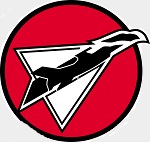Hobby Master HA38009 Israeli Defense Force General Dynamics F-16I Sufa Fighter - "470", 253 "Negev" Squadron, Ramon Airbase, Israel, 2022 (1:72 Scale)
"In striking Iraq, Israel showed that a preventive strike can be made, something that was not in doubt. Israel's act and its consequences however, make clear that the likelihood of useful accomplishment is low. Israel's strike increased the determination of Arabs to produce nuclear weapons. Arab states that may attempt to do so will now be all the more secretive and circumspect. Israel's strike, far from foreclosing Iraq's nuclear future, gained her the support of some other Arab states in pursuing it. And despite Prime Minister Begin's vow to strike as often as need be, the risks in doing so would rise with each occasion."
- Kenneth Waltz, an American political scientist. discussing the Raid on Iraq's nuclear facility known as "Osirak"
 The F-16I is a two-seat variant of the Block 52 developed for the Israeli Defense Force Air Force (IDF/AF). Israel issued a requirement in September 1997 and selected the F-16 in preference to the F-15I in July 1999. An initial "Peace Marble V" contract was signed on January 14th, 2000, with a follow on contract signed on December 19th, 2001, for a total procurement of 102 aircraft. The F-16I, which is called Sufa (Storm) by the IDF/AF, first flew on December 23rd, 2003, and deliveries to the IDF/AF began on February 19th, 2004. The F-16I has an estimated unit cost of approximately US$70 million (2006).
The F-16I is a two-seat variant of the Block 52 developed for the Israeli Defense Force Air Force (IDF/AF). Israel issued a requirement in September 1997 and selected the F-16 in preference to the F-15I in July 1999. An initial "Peace Marble V" contract was signed on January 14th, 2000, with a follow on contract signed on December 19th, 2001, for a total procurement of 102 aircraft. The F-16I, which is called Sufa (Storm) by the IDF/AF, first flew on December 23rd, 2003, and deliveries to the IDF/AF began on February 19th, 2004. The F-16I has an estimated unit cost of approximately US$70 million (2006).
The F-16I's most notable difference from the standard Block 52 is that approximately 50% of the American avionics have been replaced by Israeli-developed avionics (such as the Israeli Aerial Towed Decoy replacing the ALE-50). The addition of Israeli-built autonomous aerial combat maneuvering instrumentation systems enables the training exercises to be conducted without dependence on ground instrumentation systems, and the helmet-mounted sight is also standard equipment. The helmet-mounted sight, head-up display (HUD), mission computer, presentation computer, and digital map display are made by Elbit Systems of Israel. Furthermore, the F-16I is able to employ Rafael's new Python 5 imaging infrared-guided high-agility air-to-air missile. The F-16I also has the Israel Aircraft Industries (IAI)-built removable conformal fuel tanks (CFT) added to extend its range; removal takes two hours. Key American-sourced systems include the F100-PW-229 turbofan engine, which offers commonality with the IDF/AF's F-15Is, and the APG-68(V)9 radar
Pictured here is a gorgeous 1:72 scale diecast replica of a IDF General Dynamics F-16I Sufa fighter that was attached to the 253 "Negev" Squadron, then deployed to Ramon Airbase, Israel, during 2022.
Sold Out!
Dimensions:
Wingspan: 7-inches
Length: 8-inches
Release Date: March 2023
 Historical Account: "Operation Outside the Box" - also known as Operation Orchard was an Israeli airstrike on a suspected nuclear reactor referred to as the Al Kibar site (also referred to in IAEA documents as Dair Alzour), in the Deir ez-Zor region of Syria, which occurred just after midnight (local time) on September 6th, 2007. The Israeli and U.S. governments did not announce the secret raids for seven months. The White House and Central Intelligence Agency (CIA) subsequently confirmed that American intelligence had also indicated the site was a nuclear facility with a military purpose, though Syria denies this. A 2009 International Atomic Energy Agency (IAEA) investigation reported evidence of uranium and graphite and concluded that the site bore features resembling an undeclared nuclear reactor. IAEA was initially unable to confirm or deny the nature of the site because, according to IAEA, Syria failed to provide necessary cooperation with the IAEA investigation. Syria has disputed these claims. Nearly four years later, in April 2011 during the Syrian Civil War, the IAEA officially confirmed that the site was a nuclear reactor. Israel did not acknowledge the attack until 2018.
Historical Account: "Operation Outside the Box" - also known as Operation Orchard was an Israeli airstrike on a suspected nuclear reactor referred to as the Al Kibar site (also referred to in IAEA documents as Dair Alzour), in the Deir ez-Zor region of Syria, which occurred just after midnight (local time) on September 6th, 2007. The Israeli and U.S. governments did not announce the secret raids for seven months. The White House and Central Intelligence Agency (CIA) subsequently confirmed that American intelligence had also indicated the site was a nuclear facility with a military purpose, though Syria denies this. A 2009 International Atomic Energy Agency (IAEA) investigation reported evidence of uranium and graphite and concluded that the site bore features resembling an undeclared nuclear reactor. IAEA was initially unable to confirm or deny the nature of the site because, according to IAEA, Syria failed to provide necessary cooperation with the IAEA investigation. Syria has disputed these claims. Nearly four years later, in April 2011 during the Syrian Civil War, the IAEA officially confirmed that the site was a nuclear reactor. Israel did not acknowledge the attack until 2018.
The attack reportedly followed Israeli top-level consultations with the Bush Administration. After realizing that the US was not willing to bomb the site after being told so by U.S. President George W. Bush, Prime Minister Ehud Olmert decided to adhere to the 1981 Begin Doctrine and unilaterally strike to prevent a Syrian nuclear weapons capability, despite serious concerns about Syrian retaliation. In stark contrast to the doctrine's prior usage against Iraq, the airstrike against Syria did not elicit international outcry. A main reason is that Israel maintained total and complete silence regarding the attack, and Syria covered up its activities at the site and did not cooperate fully with the IAEA. The international silence may have been a tacit recognition of the inevitability of preemptive attacks on "clandestine nuclear programs in their early stages." If true, the Begin Doctrine has undoubtedly played a role in shaping this global perception.
According to official government confirmation on March 21st, 2018, the raid was carried out by Israeli Air Force (IAF) 69 Squadron F-15Is, and 119 Squadron and 253 Squadron F-16Is, and an ELINT aircraft; as many as eight aircraft participated and at least four of these crossed into Syrian airspace. The fighters were equipped with AGM-65 Maverick missiles, 500-pound (230 kg) bombs, and external fuel tanks. One report stated that a team of elite Israeli Shaldag special-forces commandos arrived at the site the day before so that they could highlight the target with laser designators, while a later report identified Sayeret Matkal special-forces commandos as involved.
The Israeli attack used sophisticated electronic warfare capabilities, as IAF electronic warfare (EW) systems took over Syria's air defense systems, feeding them a false sky-picture for the entire period of time that the Israeli fighter jets needed to cross Syria, bomb their target and return.
On March 6th, 2017, the Kibar nuclear site was captured by the Syrian Democratic Forces - a U.S.-backed coalition of Kurdish and Arab militia fighters - from a retreating ISIL force in northern Deir Ezzor province.


